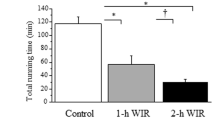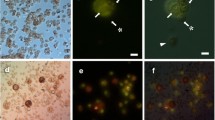Summary
A study was made of all the different stages of the phagocytic function in peritoneal macrophages from male guinea pigs [3 (SD 1) months old] before, immediately after, and 24 h after being subjected to stress from physical activity (swimming until exhaustion). The early (10 min) and late (40 min) adherence to tissue substrates, chemotaxis, attachment and phagocytosis ofCandida albicans, ingestion of inert particles (latex beads), and basal oxidative metabolism [measured by nitroblue tetrazolium (NBT) reduction] were significantly stimulated by the physical activity. After 24 h, late adherence, attachment capacities, and basal oxidative metabolism returned to basal values, whereas early adherence, chemotaxis, phagocytosis of cells and inert particles, and microbicidal capacity (production of superoxide anion measured by NBT reduction in presence of ingested material) remained significantly increased. The stress produced by physical activity, reflected in increased serum corticosterone values, led to a global stimulation of the phagocytic function.
Similar content being viewed by others
References
Bagasra O, Howeedy A, Kajdacacsy-Balla A (1988) Macrophage function in chronic experimental alcoholism. Modulation of surface receptors and phagocytosis. Immunology 65:405–409
Bieger WP, Weiss M, Michel G, Weicker H (1980) Exercise-induced monocytosis and modulation of monocyte function. Int J Sports Med 1:30–36
Boyden SV (1962) The chemotactic effect of mixture of antibody and antigen on polymorphonuclear leukocytes. J Exp Med 115:453–456
Carvajal C, Serrano M, Cervera S (1988) Estrés e inmunidad. Ciencia Méd 5:46–51
Claman HN (1972) Corticosteroids and lymphoid cells. N Engl J Med 287:388–397
Crary B, Hansen SL, Borysenko M, Kutz I, Hobanc C (1983) Epinephrine induced changes in blood of humans. J Immunol 31:1178–1181
Dantzer R, Kelley K (1989) Stress and immunity: an integrated view of relationships between the brain and the immune system. Life Sci 44:1995–2008
De la Fuente M (1985) Changes in the macrophage function with aging. Comp Biochem Physiol 811:935–938
De la Fuente M, Martin MI, Ortega E (1990) Changes in the phagocytic function of peritoneal macrophage from old mice after strenuous physical exercise. Comp Immunol Microbiol Infect Dis 13:189–198
De la Fuente M, Del Rio M, Ferrandez MD, Hernanz A (1991) Modulation of phagocytic function in murine peritoneal macrophages by bombesin, gastrin-releasing peptide and neuromedin C. Immunology 73:205–211
Douglas DJ, Hanson PG (1978) Upper respiratory infections in the conditioned athlete. Med Sci Sports Exerc 10:55
Eskola J, Ruuskanen O, Soppi E, Viljanen MK, Jarvinen M, Toivonen H (1978) Effect of sport stress on lymphocyte transformation and antibody formation. Clin Exp Immunol 32:339–345
Fehr H, Lötzerich H, Michna H (1988) The influence of physical exercise on peritoneal macrophage functions: histochemical studies. Int J Sports Med 9:78–81
Fehr H, Lötzerich H, Michna H (1989) Human macrophage function and physical exercise: phagocytic and histochemical studies. Eur J Appl Physiol 58:613–617
Ferrández MD, Del Rio M, De la Fuente M (1991) Effect of physical activity on lymphoid function in BALB/c mice. Pflügers Arch [Suppl]:R161
Fitzgerald L (1988) Exercise and the immune system. Immunol Today 9:337–339
Green RL, Kaplan SS, Rabin BS, Stantski CL, Zdziarski V (1981) Immune function in marathon runners. Ann Allergy 47:73–75
Hanson PG, Flaherty DK (1981) Immunological responses to training in conditioned runners. Clin Sci 24:225–228
Hoffman-Goetz L, Keir R, Thorne R, Houston ME, Young C (1986) Chronic exercise stress in mice depresses splenic T lymphocyte mitogenesis in vitro. Clin Exp Immunol 66:551–557
Issaad C, Ventura MA, Thomopoulos P (1989) Biphasic regulation of macrophage attachment by activators of cyclic adenosine monophosphate-dependent kinase and protein kinase C. J Cell Physiol 140:317–322
Khansari DN, Murgo AJ, Faith R (1990) Effects of stress on the immune system. Immunol Today 11:170–175
Lee TH, Nagakura T, Cromwell O, Brown MJ, Causon R, Kay AB (1984) Neutrophil chemotactic activity and histamine in atopic and nonatopic subjects after exercise-induced asthma. Am Rev Respir Dis 129:409–412
Lewicki R, Tchórzewski H, Denys A, Kowalska M, Golinska A (1987) Effect of physical exercise on some parameters of immunity in conditioned sportsmen. Int J Sports Med 8:309–314
Malec P, Tchórzewski H, Markiewicz K, Zerman K, Baj Z, Nowak Z, Pokoca L (1989) Some mechanisms of immunosuppressive action of epinephrine in humans. Allergol Immunopathol (Madr) 17:81–84
Nagy L (1983) Serum neutrophil chemotactic activity and exercise induced asthma. Eur J Respir Dis 64:161–165
Nuñez R, Rodriguez A, Barriga C, De la Fuente M (1989) In vitro and in vivo effects of imipenem on phagocytic activity of murine peritoneal macrophages. Acta Pathologica Microbiologica et Immunologica Scandinavica 97:879–886
Park BH, Fikring SM, Smithwick EM (1968) Infection and nitroblue reduction by neutrophils. A diagnostic aid. Lancet II:532–534
Ricken KH, Kinderman W (1986) Der Immunstatus des Leistungssportlers — Ursachen der Infektanfälligkeit. Dtsch Z Sportmed 37:38–42
Rodriguez AB, Barriga C, De la Fuente M (1991) Phagocytic function of blood neutrophils in sedentary young people after physical exercise. Int J Sports Med 12:276–280
Simon HB (1984) The immunology of exercise. JAMA 252:2735–2738
Sudakov KV (1980) Systems approach to the problem of emotional stress. In: Usdin E, Kuetnansky R, Kopin IJ (eds) Catecholamines and stress. Recent advances. Elsevier/North Holland, Amsterdam, p 579
Sudo A (1985) Accumulation of adrenaline in sympathetic nerve endings various organs of the rat exposed to swimming stress. J Pharmacol 38:367–374
Wit B (1984) Immunological response of regularly trained athletes. Biol Sport 3–4:221–235
Zafra C, Peña J, De la Fuente M (1988) Effect of microwaves on the activity of murine macrophages in vitro. Int Arch Allergy Appl Immunol 85:478–482
Author information
Authors and Affiliations
Rights and permissions
About this article
Cite this article
Ortega, E., Collazos, M.E., Barriga, C. et al. Stimulation of the phagocytic function in guinea pig peritoneal macrophages by physical activity stress. Europ. J. Appl. Physiol. 64, 323–327 (1992). https://doi.org/10.1007/BF00636219
Accepted:
Issue Date:
DOI: https://doi.org/10.1007/BF00636219




